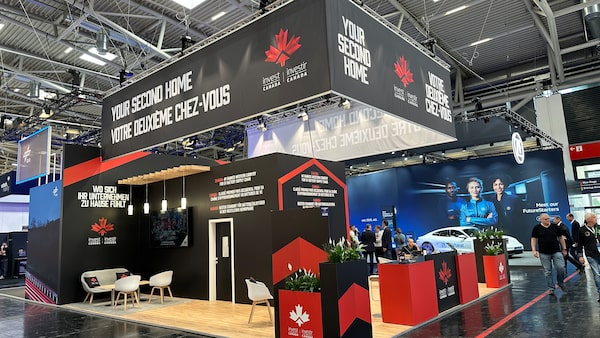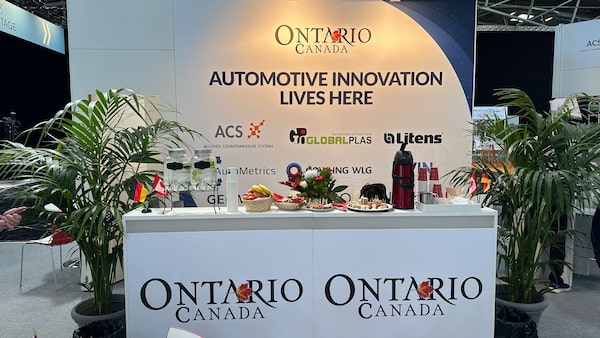
A booth at the 2023 IAA Mobility auto show in Munich, Germany by Invest in Canada to promote electric vehicle production.Mark Richardson/The Globe and Mail
There was plenty of Canada at this month’s IAA Mobility auto show in Munich.
“Your second home” and “Automotive innovation lives here,” read the signs that hung from the rafters, and were posted on the walls and at the booths. There was so much Canada that there was an Invest in Canada booth in one hall and an entirely separate booth for Ontario in another. None of the other half-dozen countries with representation at Germany’s biggest auto show had two booths.
Was Ontario competing against Canada for business?
Not at all – it’s a one-two punch, says Laurel Broten, chief executive officer of Invest in Canada, the federal agency that operated the national booth at the industry show until Sept. 8.
“We’re telling Canada’s story and we’re looking for the best opportunities to tell that story. The splash that Canada has made in the last few years as we’ve activated on the ‘mines-to-mobility’ strategy is being heard and being felt.”
Mines-to-mobility is the promise that Canada can provide everything needed for the development and construction of electric vehicles, from the raw materials to the assembly plants to the training of workers and the eventual recycling. Invest in Canada was there to press this point home to anyone who would listen.
“One of the key points that we talk about, and which is very well received, is Canada’s market access as a result of our free-trade agreements,” Ms. Broten says. “We’re a trading nation, and have access into 51 free-trade agreements. Our talent pool and our immigration strategy is very well received. Similarly, our electricity is increasingly green and very green in some parts of the country.”
Ms. Broten was speaking on the phone from the back seat of a car pressing its way through Stuttgart traffic on her way to meetings in Frankfurt. She attended the Munich show the day before, where she hosted a forum titled, The Future of the EV Battery Supply Chain: Canada’s Momentum.

An Ontario booth to promote EV production at the 2023 IAA Mobility auto show in Munich, Germany.Mark Richardson/The Globe and Mail
One of the session speakers was Marcus Breitschwerdt, former president of Mercedes-Benz Canada and now executive vice-president of Mercedes-Benz AG. Mercedes has only a retail presence in Canada, but last summer it signed a memorandum of understanding with Canada to explore ways to responsibly acquire raw materials to rapidly scale up electric vehicle production. This includes an envisioned partnership with Vancouver-based Rock Tech Lithium Inc., which could supply Mercedes with up to 10,000 tonnes of lithium hydroxide annually, taken from its Georgia Lake Project in Northern Ontario.
Canada is still flying high from last November’s report by Bloomberg New Energy Finance Ltd., which ranked Canada second in the world for its ability to feed the lithium-ion battery supply chain, close behind China and ahead of the United States. According to BloombergNEF, the ranking reflects Canada’s “large raw material resources and mining activity, as well as its good positioning in environmental, social and governance factors (ESG) and infrastructure, innovation, and industry.” However, “a lack of significant cell and component manufacturing capacity means that most of the value of these resources is realized outside of the country.”
That report was delivered before the January announcement of a partnership between Stellantis and LG Energy Solution to build a battery manufacturing plant in Windsor, Ont., and the April announcement of Volkswagen building a battery manufacturing plant in St. Thomas, Ont. They’ve been joined by subsequent announcements from General Motors, Ford and others, which add up to more than $15-billion in investments in the EV supply chain.
Most of the money is headed to Ontario, the automotive heartland of Canada. That’s music to the ears of Vic Fedeli, Ontario’s Minister of Economic Development, Job Creation and Trade, whose job it is to lure foreign companies to Ontario once they’re sold on Canada.
“Only three years ago, Reuters said $300-billion is going to be spent by companies worldwide on electric vehicles, and of that amount, zero is targeted for Canada. Zero,” Mr. Fedeli says. “When you have 100,000 men and women employed in the auto sector in Ontario, that’s very troubling news.”
Mr. Fedeli was also in Munich for the IAA Mobility show, and is now speaking by phone in the back of a van, speeding toward Salzberg on the autobahn at 150 kilometres an hour.
“We’re not in competition with Canada at all,” he says. “The Canada booth’s role is to attract companies to Canada, and they’d talk about the fact that there are exports to 51 countries, tariff-free. Their job is to whet your appetite toward Canada. Our job is to physically show them exactly the advantages in the jurisdiction of Ontario. There’s a vast difference between attracting them to Canada and then showing them where they belong within the country.”
Of the 177,576 people considered employed in Canada by the electric vehicle supply chain, which includes mining and mineral processing, battery manufacturing, cathode manufacturing, EV and EV parts manufacturing, and battery recycling, more than 139,000 are in Ontario. Mr. Fedeli wants to be sure that number grows. The Ontario booth also acted as a base for eight Ontario companies to showcase their EV component products.
Mr. Fedeli is quick to point out that you don’t need to leave the province to find everything needed to make a lithium-ion battery, then put it in an Ontario-made car that’s built from Ontario-made steel by workers trained in Ontario. Even the eventual recycling of EV batteries is available in Ontario.
“There’s lots of runway ahead of us, but quite frankly, it’s not a forever market, because in the next 12 months, most companies worldwide are going to find a partner and find a location,” he says.
“This isn’t a 2050 or a 2040 or even a 2035 issue. You’ve got to be meeting federal and worldwide government numbers by 2032, so you’re going to need to start building a plant next year.
“So there’s lots of runway ahead, but it’s still a limited runway. I’m going to mix my metaphors here: It’s a carousel, and when that carousel stops, there’s not going to be a horse for everybody.”
The writer was a guest of Mercedes-Benz. Content was not subject to approval.
Editor’s note: An earlier version of this story stated Laurel Broten is chief investment officer of Invest in Canada. In fact, she is chief executive officer.
 Mark Richardson
Mark Richardson